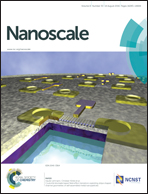Charge transport through dicarboxylic-acid-terminated alkanes bound to graphene–gold nanogap electrodes†
Abstract
Graphene-based electrodes are attractive for single-molecule electronics due to their high stability and conductivity and reduced screening compared with metals. In this paper, we use the STM-based matrix isolation I(s) method to measure the performance of graphene in single-molecule junctions with one graphene electrode and one gold electrode. By measuring the length dependence of the electrical conductance of dicarboxylic-acid-terminated alkanes, we find that the transport is consistent with phase-coherent tunneling, but with an attenuation factor of βN = 0.69 per methyl unit, which is lower than the value measured for Au–molecule–Au junctions. Comparison with density-functional-theory calculations of electron transport through graphene–molecule–Au junctions and Au–molecule–Au junctions reveals that this difference is due to the difference in Fermi energies of the two types of junction, relative to the frontier orbitals of the molecules. For most molecules, their electrical conductance in graphene–molecule–Au junctions is higher than that in Au–molecule–Au junctions, which suggests that graphene offers superior electrode performance, when utilizing carboxylic acid anchor groups.



 Please wait while we load your content...
Please wait while we load your content...